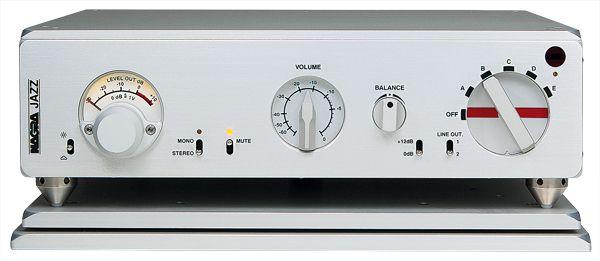Nagra Jazz/msa ( Jazz, £8750; Msa, £6450)

And Nagra says the preamp’s circuitry – which employs 2x12AX7/ECC83s and 1x12AT7/ECC81 dual-triode valves – has been completely rethought to improve stability and reduce noise to the point where its engineers no longer consider a battery power supply a necessity. The Jazz is powered by a hideaway PSU that delivers DC to the main unit via a cable terminated with a Lemo connector.
It has five line inputs labelled A-to-E, four of which are single-ended (RCA) while input ‘A’ uses XLRs. When the preamp is in its standard form, this XLR input is asymmetrical but optional input transformers can be fitted for true balanced operation.
A small switch on the fascia, next to the rotary input selector, toggles between Output 1 (balanced, XLRs) and Output 2 (single-ended, two sets of paralleled RCAs for easy bi-amping), while the switch next to it changes the internal gain (unity or +12dB). Stereo/mono and mute switches are also featured.
For this review, we paired the preamplifier with Nagra’s MSA power amp introduced in 2009. Rated at 60W/8ohm it employs just a pair of MOSFETs per channel in a deliberately simple, fully balanced circuit arrangement. The output devices are coupled to the amplifier’s substantial top-mounted heatsink which is milled from an aluminium block. Even driven hard the unit barely gets warm.
In keeping the amplifier so compact, Nagra has employed a sophisticated switch-mode power supply featuring a hefty toroidal transformer. You can use a supplied jumper to bridge the amplifier’s two channels and double its output power. A three-position switch selects between stereo, bridged mono, or ‘double mono’ whereby each channel is entirely separated for bi-amping a loudspeaker.
Uncanny imaging
Listening to Jacqueline du Pré and Daniel Barenboim performing the two Brahms cello sonatas [EMI] showed immediately that this combo makes for a delightful pairing, the cello’s dusky woodiness being reproduced with vivid presence and spaciousness. The imaging was as good as we’ve ever experienced in our listening room – the sense of two instruments ‘hanging in the air’, cello slightly in front of piano, was uncanny. Furthermore, the piano was reproduced with convincing percussive attack and decay, the Jazz/MSA pairing creating a rock-solid sonic picture with commendable precision.
The sound is exceptionally clear and crisp at high frequencies. The shimmer of cymbals as their reverberation tails decay to silence took our breath away as we listened to a selection of purist audiophile recordings. We were blown away by the sense of spatial realism the Nagra combo delivered, and the ‘cleanliness’ of the sound – especially when playing New York-based guitarist Stew Cutler’s ‘Lovely Mary’ from his album Insignia [Naim label: CD or 24-bit/96kHz download]. The purity of the sound – the lifelike dynamics and naturalness of the percussion in particular – speaks volumes for the transparency and top-notch detail retrieval of Nagra’s electronics.
We ‘progged out’ to Steve Hackett and Chris Squire’s A Life Within A Day [Esoteric]. The production is rather dense, yet the Nagra proved tremendous at peeling through the blanket layers of the mix and creating space, Squire’s fat and characteristically twangy bass riff patterns underpinning the myriad keyboard, guitar and reverberant vocal lines.
Verdict
These components are beautifully built and lovely to use. Audiophiles looking for high-end performance in a jewel-like package should certainly hear the new Jazz preamp – preferably in combination with Nagra’s MSA.
Originally published in the 2013 Yearbook























































